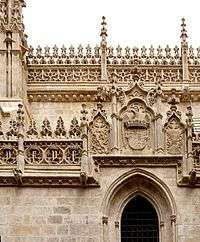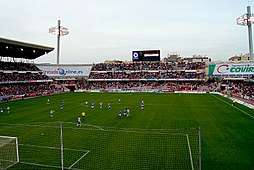Granada
Granada (/ɡrəˈnɑːdə/ grə-NAH-də, Spanish: [ɡɾaˈnaða]) [lower-alpha 1], locally [ɡɾaˈna][5] is the capital city of the province of Granada, in the autonomous community of Andalusia, Spain. Granada is located at the foot of the Sierra Nevada mountains, at the confluence of four rivers, the Darro, the Genil, the Monachil and the Beiro. It sits at an average elevation of 738 m (2,421 ft) above sea level, yet is only one hour by car from the Mediterranean coast, the Costa Tropical. Nearby is the Sierra Nevada Ski Station, where the FIS Alpine World Ski Championships 1996 were held.
Granada | |
|---|---|
Municipality | |
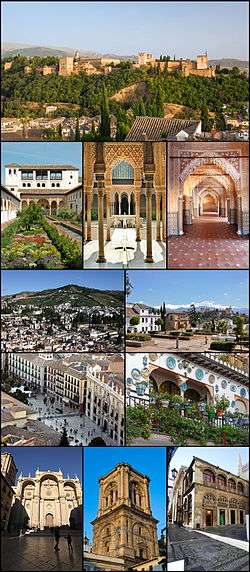 From top left: The Alhambra, Generalife, Patio de los Leones in Alhambra, Royal Hall in Alhambra, Albayzín and Sacromonte, Huerto del Carlos, in Albayzín, Plaza Nueva, house in Albayzín, façade of the cathedral, bell tower of the cathedral, Royal Chapel | |
 Flag 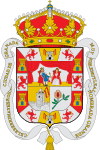 Coat of arms | |
 Granada Location of Granada in Spain | |
| Coordinates: 37°10′41″N 3°36′03″W | |
| Country | Spain |
| Autonomous Community | Andalusia |
| Province | Granada |
| Comarca | Vega de Granada |
| Government | |
| • Type | Ayuntamiento |
| • Body | Ayuntamiento de Granada |
| • Mayor | Luis Salvador (Cs) |
| Area | |
| • Total | 88.02 km2 (33.98 sq mi) |
| Elevation (AMSL) | 738 m (2,421 ft) |
| Population (2018)[1] | |
| • Total | 232,208 |
| • Density | 2,600/km2 (6,800/sq mi) |
| Demonyms | granadino (m.), granadina (f.) iliberitano (m.), iliberitana (f.), granadí, garnatí |
| Time zone | UTC+1 (CET) |
| • Summer (DST) | UTC+2 (CEST) |
| Postal codes | 18001–18019 |
| Area code(s) | +34 (Spain) + (Granada) |
| Website | Official website |
In the 2005 national census, the population of the city of Granada proper was 236,982, and the population of the entire urban area was estimated to be 472,638, ranking as the 13th-largest urban area of Spain. About 3.3% of the population did not hold Spanish citizenship, the largest number of these people (31%; or 1% of the total population) coming from South America. Its nearest airport is Federico García Lorca Granada-Jaén Airport.
The Alhambra, an Arab citadel and palace, is located in Granada. It is the most renowned building of the Islamic historical legacy with its many cultural attractions and architectural elements that make Granada a popular destination among the tourist cities of Spain. The Almohad influence on architecture is also preserved in the Granada neighborhood called the Albaicín with its fine examples of Moorish and Morisco construction. Granada is also well-known within Spain for the University of Granada which has an estimated 82,000 students spread over five different campuses in the city. The pomegranate (in Spanish, granada) is the heraldic device of Granada.
History
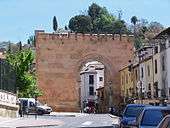
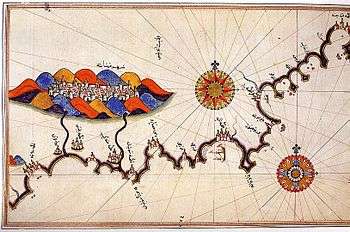
Pre-Umayyad history
The region surrounding what today is Granada has been populated since at least 5500 BC and experienced Roman and Visigothic influences. The most ancient ruins found in the city belong to an Iberian oppidum called Ilturir, in the region known as Bastetania. This oppidum eventually changed its name to Iliberri, and after the Roman conquest of Iberia, to Municipium Florentinum Iliberitanum.[6]
Founding and early history
The Umayyad conquest of Hispania, starting in AD 711, brought large parts of the Iberian Peninsula under Moorish control and established al-Andalus. Granada's historical name in the Arabic language was غرناطة (Ġarnāṭah).[6][7][8][9] The word Gárnata (or Karnatah) possibly means "hill of strangers". Because the city was situated on a low plain and, as a result, difficult to protect from attacks, the ruler decided to transfer his residence to the higher situated area of Gárnata. According to Arabic sources Ilbira (Elvira) was razed during Fitna of al-Andalus, afterwards it was not restored at its previous place and instead Garnata, which was a Jewish ghetto before, replaced it as the main city. In a short time this town was transformed into one of the most important cities of al-Andalus.[6][8]
In the early 11th century, after the collapse of the Umayyad Caliphate, the Berber Zawi ben Ziri established an independent kingdom for himself, the Taifa of Granada. His surviving memoirs – the only ones for the Spanish "Middle Ages"[10] – provide considerable detail for this brief period. The Zirid Taifa of Granada was a Jewish state in all but name; the Muslim king is looked upon as a mainly symbolic figurehead. It was the center of Jewish Sephardi culture and scholarship.
Early Arabic writers repeatedly called it "Garnata al-Yahud" (Granada of the Jews).... Granada was in the eleventh century the center of Sephardic civilization at its peak, and from 1027 until 1066 Granada was a powerful Jewish state. Jews did not hold the foreigner (dhimmi) status typical of Islamic rule. Samuel ibn Nagrilla, recognized by Sephardic Jews everywhere as the quasi-political ha-Nagid ('The Prince'), was king in all but name. As vizier he made policy and—much more unusual—led the army.... It is said that Samuel's strengthening and fortification of Granada was what permitted it, later, to survive as the last Islamic state in the Iberian peninsula.
All of the greatest figures of eleventh-century Hispano-Jewish culture are associated with Granada. Moses Ibn Ezra was from Granada; on his invitation Judah ha-Levi spent several years there as his guest. Ibn Gabirol’s patrons and hosts were the Jewish viziers of Granada, Samuel ha-Nagid and his son Joseph.[11]
When Joseph took over after his father's death, he proved to lack his father's diplomacy, bringing on the 1066 Granada massacre, which ended the Golden age of Jewish culture in Spain.
By the end of the 11th century, the city had spread across the Darro to reach the hill of the future Alhambra, and included the Albaicín neighborhood (now a World Heritage site).[12] The Almoravids ruled Granada from 1090 and the Almohad dynasty from 1166.[13]
Nasrid dynasty—Emirate of Granada
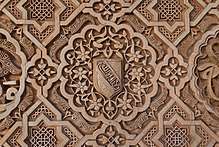
In 1228, with the departure of the Almohad prince Idris al-Ma'mun, who left Iberia to take the Almohad leadership, the ambitious Ibn al-Ahmar established the last and longest reigning Muslim dynasty in the Iberian peninsula, the Nasrids. With the Reconquista in full swing after the conquest of Córdoba in 1236, the Nasrids aligned themselves with Fernando III of Castile, officially becoming the Emirate of Granada in 1238.[13] Most historians agree that Granada became a tributary state to the Kingdom of Castile from that year, although this was often interrupted by wars between the two states.[14] It provided connections with Muslim and Arab trade centers, particularly for gold from sub-Saharan Africa and the Maghreb, and exported silk and dried fruits produced in the area.[15] The Nasrids also supplied troops from the Emirate and mercenaries from North Africa for service to Castile.
Ibn Battuta, a famous traveller and an authentic historian, visited the Kingdom of Granada in 1350. He described it as a powerful and self-sufficient kingdom in its own right, although frequently embroiled in skirmishes with the Kingdom of Castile. In his journal, Ibn Battuta called Granada the "metropolis of Andalusia and the bride of its cities."[16]
During the Moor rule, Granada was a city with adherents to many religions and ethnicities (Arabs, Berbers, Christians and Jews) who lived in separate quarters. During this Nasrid period there were 137 Muslim mosques in the Medina (city) of Granada.[17]
Reconquista and the 16th century
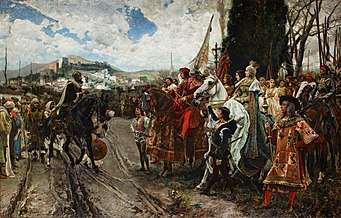
On January 2, 1492, the last Muslim ruler in Iberia, Emir Muhammad XII of Granada, known as "Boabdil" to the Spanish, surrendered complete control of the Emirate of Granada to Ferdinand II of Aragon and Isabella I of Castile, Los Reyes Católicos ("the Catholic Monarchs"), after the last battle of the Granada War.
The 1492 surrender of the Kingdom of Granada to the Catholic Monarchs is one of the most significant events in Granada's history as it marks the completion of the Reconquista. The terms of the surrender, expressed in the Alhambra Decree treaty, explicitly allowed the city's Muslim inhabitants, known as Mudéjars, to continue unmolested in the practice of their faith and customs. By 1499, however, Cardinal Francisco Jiménez de Cisneros grew frustrated with the slow pace of the efforts of the first archbishop of Granada, Hernando de Talavera, to convert non-Christians to Christianity and undertook a program of forced Christian baptisms, creating the Converso (convert) class for Muslims and Jews. Cisneros's new tactics, which were a direct violation of the terms of the treaty, provoked the Rebellion of the Alpujarras (1499–1501) centered in the rural Alpujarras region southwest of the city.
Responding to the rebellion of 1501, the Castilian Crown rescinded the Alhambra Decree treaty, and mandated that Granada's Muslims convert or emigrate. Under the 1492 Alhambra Decree, Spain's Jewish population, unlike the Muslims, had already been forced to convert under threat of expulsion or even execution, becoming Marranos (meaning "pigs" in Spanish), or Catholics of Jewish descent. Many of the elite Muslim class subsequently emigrated to North Africa. The majority of the Granada's Mudéjar Muslims converted so that they could stay, however, becoming Moriscos, or Catholics of Moorish descent ("Moor" being equivalent to Muslim). Both populations of conversos were subject to persecution, execution, or exile, and each had cells that practiced their original religion in secrecy.
Over the course of the 16th century, Granada took on an ever more Catholic and Castilian character, as immigrants came to the city from other parts of the Iberian Peninsula. The city's mosques were converted to Christian churches or completely destroyed. New structures, such as the cathedral and the Chancillería, or Royal Court of Appeals, transformed the urban landscape. After the 1492 Alhambra decree, which resulted in the majority of Granada's Jewish population being expelled, the Jewish quarter (ghetto) was demolished to make way for new Catholic and Castilian institutions and uses.
Legacy
The fall of Granada has a significant place among the important events that mark the latter half of the Spanish 15th century. It completed the so-called "Reconquista" (or Christian reconquest) of the almost 800-year-long Islamic rule in the Iberian Peninsula. Spain, now without any major internal territorial conflict, embarked on a great phase of exploration and colonization around the globe. In the same year, the sailing expedition of Christopher Columbus resulted in what is usually claimed to be the first European sighting of the New World, although Leif Erikson is often regarded as the first European to land in the New World, 500 years before Christopher Columbus. The resources of the Americas enriched the crown and the country, allowing Queen Isabella and King Ferdinand to consolidate their rule as Catholic Monarchs of the united kingdoms. Subsequent conquests, and the Spanish colonization of the Americas by the maritime expeditions they commissioned, created the vast Spanish Empire: for a time, the largest in the world.
Heritage and monuments
The greatest artistic wealth of Granada is its Spanish-Islamic art – in particular, the compound of the Alhambra and the Generalife. The Generalife is a pleasure palace with attached romantic gardens, remarkable both for its location and layout, as well as for the diversity of its flowers, plants and fountains. The Alhambra is the architectural culmination of the works of Nasrid art that were undertaken in the 13th and 14th centuries, with most of the Alhambra having been built at the time of Yusuf I and Mohammed V, between 1333 and 1354.
At present, the buildings of Granada are typically bourgeois in appearance, with much of the architecture dating from the 19th Century, together with numerous Renaissance and Baroque buildings.
Alhambra
.jpg)
The Alhambra is a Nasrid "palace city". It was declared a World Heritage site by UNESCO in 1984. It is certainly Granada's most emblematic monument and one of the most visited in Spain. It consists of a defensive zone, the Alcazaba, together with others of a residential and formal state character, the Nasrid Palaces and, lastly, the palace, gardens and orchards of the Generalife.
The Alhambra occupies a small plateau on the southeastern border of the city in the foothills of the Sierra Nevada above the Assabica valley. Some of the buildings may have existed before the arrival of the Moors. The Alhambra as a whole is completely walled, bordered to the north by the valley of the Darro, to the south by the al-Sabika, and to the east of the Cuesta del Rey Chico, which in turn is separated from the Albaicín and Generalife, located in the Cerro del Sol.
In the 11th century the Castle of the Alhambra was developed as a walled town which became a military stronghold that dominated the whole city. But it was in the 13th century, with the arrival of the first monarch of the Nasrid dynasty, Muhammad I of Granada (Mohammed I, 1238–1273), that the royal residence was established in the Alhambra. This marked the beginning of its heyday. The Alhambra became palace, citadel and fortress, and was the residence of the Nasrid sultans and their senior officials, including servants of the court and elite soldiers (13th–14th centuries).
In 1492 the Catholic Monarchs, Ferdinand and Isabela, expelled the final Moors from the city of Granada. They established permanent residency in the Alhambra, and it was here that Christopher Columbus requested royal endorsement for his westward expedition that year.
In 1527 Charles V, Holy Roman Emperor demolished part of the architectural complex to build the Palace which bears his name. Although the Catholic Monarchs had already altered some rooms of the Alhambra after the conquest of the city in 1492, Charles V wanted to construct a permanent residence befitting an emperor. Around 1537 he ordered the construction of the Peinador de la Reina, or Queen's dressing room, where his wife Isabel lived, over the Tower of Abu l-Hayyay.
.jpg)
There was a pause in the ongoing maintenance of the Alhambra from the 18th century for almost a hundred years, and during control by the First French Empire, substantial portions of the fortress were blown apart. The repair, restoration and conservation that continues to this day did not begin until the 19th century. The complex currently includes the Museum of the Alhambra, with objects mainly from the site of the monument itself and the Museum of Fine Arts.[18]

Other monuments
Since 1988, there is in Granada a monument honoring Judah ben Saul ibn Tibbon[19].
Generalife
.jpg)
The Generalife is a garden area attached to the Alhambra which became a place of recreation and rest for the Granadan Muslim kings when they wanted to flee the tedium of official life in the Palace. It occupies the slopes of the hill Cerro del Sol above the ravines of the Genil and the Darro and is visible from vantage points throughout the city. It was conceived as a rural village, consisting of landscaping, gardens and architecture. The palace and gardens were built during the reign of Muhammed III (1302–1309) and redecorated shortly after by Abu l-Walid Isma'il (1313–1324). It is of the Islamic Nasrid style, and is today one of the biggest attractions in the city of Granada. The Generalife was declared a World Heritage Site by UNESCO in 1984.
It is difficult to know the original appearance of the Generalife, as it has been subject to modifications and reconstructions throughout the Christian period which disfigured many of its former aspects. All buildings of the Generalife are of solid construction, and the overall decor is austere and simple. There is little variety to the Alhambra's decorative plaster, but the aesthetic is tasteful and extremely delicate. In the last third of the 20th century, a part of the garden was destroyed to build an auditorium.[20]
Cathedral
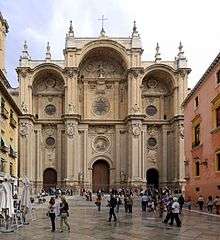
The cathedral of Granada is built over the Nasrid Great Mosque of Granada, in the centre of the city. Its construction began during the Spanish Renaissance in the early 16th century, shortly after the conquest of Granada by the Catholic Monarchs, who commissioned the works to Juan Gil de Hontañón and Enrique Egas. Numerous grand buildings were built in the reign of Charles V, Holy Roman Emperor, so that the cathedral is contemporary to the Christian palace of the Alhambra, the University and the Real Chancillería (Supreme Court).
The church was conceived on the model of the Cathedral of Toledo, for what initially was a Gothic architectural project, as was customary in Spain in the early decades of the 16th century. However, Egas was relieved by the Catholic hierarchy in 1529, and the continuation of the work was assigned to Diego Siloe, who built upon the example of his predecessor, but changed the approach towards a fully Renaissance aesthetic.[21]
The architect drew new Renaissance lines for the whole building over the gothic foundations, with an ambulatory and five naves instead of the usual three. Over time, the bishopric continued to commission new architectural projects of importance, such as the redesign of the main façade, undertaken in 1664 by Alonso Cano (1601–1667) to introduce Baroque elements. In 1706 Francisco de Hurtado Izquierdo and later his collaborator José Bada built the current tabernacle of the cathedral.
Highlights of the church's components include the main chapel, where may be found the praying statues of the Catholic Monarchs, which consists of a series of Corinthian columns with the entablature resting on their capitals, and the vault over all. The spaces of the walls between the columns are perforated by a series of windows. The design of the tabernacle of 1706 preserves the classic proportions of the church, with its multiple columns crossing the forms of Diego de Siloé.[22]
Royal Chapel
The Catholic Monarchs chose the city of Granada as their burial site by a royal decree dated September 13, 1504. The Royal Chapel of Granada, built over the former terrace of the Great Mosque, ranks with other important Granadan buildings such as the Lonja and the Catedral e Iglesia del Sagrario. In it are buried the Catholic Monarchs, their daughter Joanna of Castile (Juana la Loca) and her husband Felipe I (Felipe el Hermoso). Construction of the Chapel started in 1505, directed by its designer, Enrique Egas. Built in several stages, the continuing evolution of its design joined Gothic construction and decoration with Renaissance ideals, as seen in the tombs and the 17th and 18th century Granadan art in the Chapel of Santa Cruz. Over the years the church acquired a treasury of works of art, liturgical objects and relics.
The Royal Chapel was declared a Historic Artistic Monument on May 19, 1884, taking consideration of BIC (Bien de Interés Cultural) status in the current legislation of Spanish Historical Heritage (Law 16/1985 of 25 June). The most important parts of the chapel are its main retable, grid and vault. In the Sacristy-Museum is the legacy of the Catholic Monarchs. Its art gallery is highlighted by works of the Flemish, Italian and Spanish schools.[23]
 Hans Memling - Diptych of Granada, left wing:Acceptance of the Cross, h. 1475
Hans Memling - Diptych of Granada, left wing:Acceptance of the Cross, h. 1475 Juan de Flandes - Birth of Christ, 1435-1438
Juan de Flandes - Birth of Christ, 1435-1438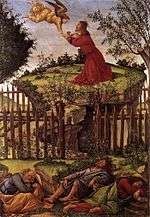 Sandro Botticelli - Prayer of the Garden, 1498-1500
Sandro Botticelli - Prayer of the Garden, 1498-1500
Albayzín
The Albayzín (or Albaicín) is a neighborhood of Al-Andalus origin, much visited by tourists who flock to the city because of its historical associations, architecture, and landscape.
The archeological findings in the area show that it has been inhabited since ancient times. It became more relevant with the arrival of the Zirid dynasty, in 1013, when it was surrounded by defensive walls. It is one of the ancient centres of Granada, like the Alhambra, the Realejo and the Arrabal de Bib-Rambla, in the flat part of the city. Its current extension runs from the walls of the Alcazaba to the cerro of San Miguel and on the other hand, from the Puerta de Guadix to the Alcazaba.
This neighborhood had its greatest development in the Nasrid era, and therefore largely maintains the urban fabric of this period, with narrow streets arranged in an intricate network that extends from the upper area, called San Nicolás, to the river Darro and Calle Elvira, located in the Plaza Nueva. The traditional type of housing is the carmen granadino, consisting of a free-standing house surrounded by a high wall that separates it from the street and includes a small orchard or garden.
In the Muslim era the Albayzín was characterized as the locus of many revolts against the caliphate. At that time it was the residence of craftsmen, industrialists and aristocrats. With the Christian reconquest, it would progressively lose its splendor. The Christians built churches and settled there the Real Chancillería. During the rule of Felipe II of Spain, after the rebellion and subsequent expulsion of the Moors, the district was depopulated. In 1994 it was declared a Unesco World Heritage Site.[24] Of its architectural wealth among others include the Ziri walls of the Alcazaba Cadima, the Nasrid walls, the towers of the Alcazaba, the churches of Salvador (former main mosque), San Cristóbal, San Miguel Alto and the Real Chancillería.[25]
Sacromonte
The Sacromonte neighbourhood is located on the Valparaíso hill, one of several hills that make up Granada. This neighborhood is known as the old neighbourhood of the Romani, who settled in Granada after the conquest of the city. It is one of the most picturesque neighborhoods, full of whitewashed caves cut into the rock and used as residences. The sound of strumming guitars may still be heard there in the performance of flamenco cantes and quejíos, so that over time it has become one of the most popular tourist attractions in Granada.
At the top of this hill is the Abbey of Sacromonte and the College of Sacromonte, founded in the 17th century by the then Archbishop of Granada Pedro de Castro. The Abbey of Sacromonte was built to monitor and guard the alleged relics of the evangelists of Baetica. Those are of questionable authenticity, but since their finding the area has been a religious pilgrimage destination.[26]
The abbey complex consists of the catacombs, the abbey (17th–18th centuries), the Colegio Viejo de San Dionisio Areopagita (17th century) and the Colegio Nuevo (19th century). The interior of the church is simple and small but has numerous excellent works of art, which accentuate the size and rich carving of the Crucificado de Risueño, an object of devotion for the Romani people, who sing and dance in the procession of Holy Week. The facilities also include a museum, which houses the works acquired by the Foundation.[27]
Charterhouse
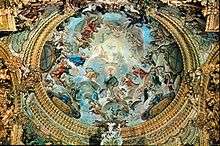
The Charterhouse of Granada is a monastery of cloistered monks, located in what was a farm or Muslim almunia called Aynadamar ("fountain of tears") that had an abundance of water and fruit trees. The initiative to build the monastery in that place was begun by Gonzalo Fernández de Córdoba, known as El Gran Capitán. The charterhouse was founded in 1506; construction started ten years later, and continued for the following 300 years.
The Monastery suffered heavy damage during the Peninsular War and lost considerable property in 1837 as a result of the confiscations of Mendizábal. Currently, the monastery belongs to the Carthusians, reporting directly to the Archdiocese of Granada.[28]
The street entrance to the complex is an ornate arch of Plateresque style. Through it one reaches a large courtyard, at the end which is a wide staircase leading to the entrance of the church. The church, of early 16th century style and plan, has three entrances, one for the faithful and the other two for monks and clergy. Its plan has a single nave divided into four sections, highlighting the retables of Juan Sánchez Cotán and the chancel's glass doors, adorned with mother-of-pearl, silver, rare woods and ivory. The presbytery is covered by elliptical vaulting. The main altar, between the chancel arch and the church tabernacle, is gilded wood.
The church's tabernacle and sancta sanctorum are considered a masterpiece of Baroque Spanish art in its blend of architecture, painting and sculpture. The dome that covers this area is decorated with frescoes by the Córdoba artist Antonio Palomino (18th century) representing the triumph of the Church Militant, faith, and religious life.
The courtyard, with galleries of arches on Doric order columns opening on it, is centered by a fountain. The Chapter House of Legos is the oldest building of the monastery (1517). It is rectangular and covered with groin vaulting.[29]
Mosque of Granada
The Mosque of Granada was inaugurated in 2003 on the summit of the neighborhood of Albayzin. The mosque was built near the Church of San Salvador and the Church of San Nicolás. The Church of San Salvador was built on the site of the Great Mosque of Albayzin. The Society for the Return of Islam in Spain purchased the site in 1981, but it took many years for the plans to be approved. The mosque's initial funding was supplied by Shaykh 'Abdalqadir as-Sufi al-Murabit who envisioned providing Granada's new Spanish Muslim community with a mosque. Additional funding came from Malaysia, Morocco and the United Arab Emirates. In 1991 the CIE (Comunidad Islámica en España) hired the architect Renato Ramirez Sanchez to design the mosque. In the 1990s, there was a heated debate pertaining to the design of the minaret. Construction eventually began in 2001. The mosque now serves about 500 people.[30]
Palace of the Marqués de Salar
The Palace of the Marqués de Salar was built in one of the most emblematic streets of Granada, the Carrera del Darro, at number 5. This place is an architectural example of the classical Granada during the Renaissance transformation of the XVIth century. It was built by the Marqués de Salar, great-grandson of both Hernán Pérez del Pulgar (known by the name of El de la Hazañas [The One of the Valiant Deeds]) and Gonzalo Fernández de Córdoba (El Gran Capitán [The Great Captain]), Captain-General of the Castilian-Aragonese forces that concluded the Reconquest of the peninsula. The palace is now the museum of perfumes El Patio de los Perfumes, with 1,500 square metres (16,000 sq ft) of floor space on two floors and 130 square metres (1,400 sq ft) of patio to relax surrounded by flowers and perfumes.
Other buildings
Politics and administration
Metropolitan area of Granada
Granada's metropolitan area consists of about fifty municipalities and the capital. Although it is not formally constituted as a political and administrative body, there are several public services that are combined. The arrival of many inhabitants of the capital and other towns in the province, influences a large Population growth. Despite the fact that the capital loses inhabitants, who move to neighboring towns. The main causes of the exodus towards the towns of the metropolitan area are, mainly, the difficulty of accessing a home in the capital because of the high prices it has and labor reasons, because in the towns of the periphery the majority are being located of industrial estates.
Capital of Granada Province
The city of Granada is the capital of the province of the same name, thus all administrative entities of provincial scope dependent on the regional government and the state are located there. There is a provincial delegation from each of the governmental departments to the Junta de Andalucía, coordinated by a government delegate under the Ministry of the Interior. The national government of Spain has a sub-delegation in Granada, subordinate to the government delegate in the autonomous community.
Judicial administration
The headquarters of the Superior Court of Justice of Andalusia, Ceuta and Melilla is in Granada, located in Plaza Nueva, in the building of the historic Royal Chancery, as well as the Superior Prosecutor's Office of Andalusia, located in the building of the Bank of Spain. It has a Provincial Court, located in Corteza del Carmen Street, and is also head of the Judicial Party No. 3 of the province, whose demarcation includes the city and 49 towns, some of them very populated, in the metropolitan area region.
Most of the courts are located in two administrative buildings, in Plaza Nueva and Avenida del Sur. The set of judicial bodies is as follows:
- Superior Court of Justice: President. Civil-Criminal Chamber. Contentious-Administrative Room. Social room.
- Provincial Court: President. Criminal: 2; Civil: 3
- Courts
Municipal organization
Its political administration is carried out through a City Council, of democratic management, whose components are chosen every four years by universal suffrage. The electoral roll is composed of all residents registered in Granada over 18 years of age, of Spanish nationality and of the other member countries of the European Union. According to the provisions of the General Electoral Regime Law, which establishes the number of eligible councilors according to the population of the municipality, the Municipal Corporation of Granada is made up of 27 councilors. In the municipal elections held in 2019 the constitution of the City Council was eleven councilors belonging to the Popular Party, eight to the Socialist Party, four belonging to Citizens Party, three to Vamos, Granada and one to the United Left-Socialist Alternative-For the People. After these results with the rise of the new political forces, PP and PSOE lost power; and after negotiations an agreement was reached with which José Torres Hurtado, mayor of the Popular Party, continues as mayor, under the supervision of the regeneration compliance required by the Citizens party. After his resignation, due to his involvement in Operation Serrallo / Nazarí, the socialist Francisco Cuenca was appointed mayor.
Municipal districts and neighborhoods
The municipality of Granada consists of eight districts whose population is distributed in the attached chart according to the 2009 census of the City of Granada. These districts formed a set of 36 neighborhoods. All boundaries of districts and neighborhoods were modified in February 2013.
Municipal service areas
The municipal government team has organized the distribution of management responsibilities, structuring itself in the following service areas: Weddings and Palaces, Equal opportunities, Economy, Education, Communication office, Unified license management, Youth, Environment, Municipal Office of Consumer Information, Citizen Participation, Group of Civil Protection Volunteers, Local Police.
Districts
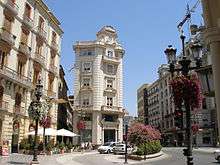
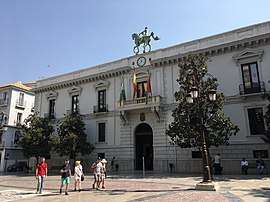
Realejo
Realejo was the Jewish district in the time of the Nasrid Granada. (The centuries since the Jewish population were so important that Granada was known in Al-Andalus under the name of "Granada of the Jews", Arabic: غرناطة اليهود Gharnāṭah al-Yahūd.) It is today a district made up of many Granadinian villas, with gardens opening onto the streets, called Los Cármenes.
Cartuja
This district contains the Carthusian monastery of the same name: Cartuja. This is an old monastery started in a late Gothic style with Baroque exuberant interior decorations. In this district also, many buildings were created with the extension of the University of Granada.
Bib-Rambla
The toponym derives from a gate (Bab al-Ramla, or the Gate of the Ears) that was built when Granada was controlled by the Nasrid dynasty. Nowadays, Bib-Rambla is a high point for gastronomy, especially in its terraces of restaurants, open on beautiful days. The Arab bazaar (Alcaicería) is made up of several narrow streets, which start from this place and continue as far as the cathedral
Sacromonte
The Sacromonte neighborhood is located on the extension of the hill of Albaicín, along the Darro River. This area, which became famous by the nineteenth century for its predominantly Gitano inhabitants, is characterized by cave houses, which are dug into the hillside. The area has a reputation as a major center of flamenco song and dance, including the Zambra Gitana, an Andalusian dance originating in the Middle East. The zone is a protected cultural environment under the auspices of the Centro de Interpretación del Sacromonte, a cultural center dedicated to the preservation of Gitano cultural forms.
Zaidín
This formerly blue collar but now upmarket neighborhood houses 100,000 residents of Granada, making it the largest neighborhood or 'barrio'. Traditionally populated by Romani people, now many residents are from North and West Africa, China, and many South American countries. Every Saturday morning it hosts a large outdoor market or "mercadillo", where many people come and sell their wares of fruits and vegetables, clothes and shoes, and other odds and ends.
Gastronomy
The gastronomy of Granada is part of the Arabic-Andalusian cuisine tradition, with a strong Arab and Jewish heritage, which is reflected in its condiments and spices, such as cumin, coriander, nutmeg, cinnamon, raisins, almonds or honey. The writer Miguel Alcobendas, author of the traditional cuisine of Granada, says that it has its origin in living together, from the thirteenth to the fifteenth century (when Granada surrendered to the Catholic Kings), of Muslims, Jews and Christians in the Nasrid Kingdom from Granada. Subsequently there was a miscegenation with the kitchen of the Christians, in which the pork acquired an importance in the kitchen of Granada more than in the rest of Spain, since its consumption allowed its eaters to demonstrate a certain distance from the persecuted religions, since both Muslims and Jews have it banned.
The climatic differences of the different regions of the province, from the coast to the peaks of the Sierra Nevada propitiates a great variety of raw materials: vegetables], meats and sausages, fish that are combined in a multitude of dishes and recipes for soups and stews.
The famous and reputed Trevélez ham comes from the Sierra of Granada, to which other pork derivatives are added, sausages such as chorizo, black pudding and pork tenderloin.
Ham and beans, two products of the land, are combined in one of its most typical dishes, beans with ham; Other known dishes are the Sacromonte tortilla, which among other ingredients must have cooked brains and veal crustaillas, chopped and sauted before mixing with the egg. It is also worth mentioning "papas a lo pobre", potatoes which are usually served with egg and fried peppers, as well as with pieces of pork or ham.
Among the stews and potajes, the pot of San Antón stands out, which is eaten mainly towards the second half of January; cabbage stew, which combines vegetables and legumes; the stew of green beans and fennel; The thistle and pumpkin casserole, with noodles and aromatic herbs, or gypsy pottery are other dishes of the land.
Confectionery is well represented in the gastronomy of Granada, for sweets prepared by the nuns can be purchased in the numerous convents of the city: the pestiños of Vélez or those of the Encarnación, the puff pastries of San Jerónimo, the moles of San Antón eggs, the Zafra biscuit, sweet potato rolls, cocas, roscos from Santo Tomas and mantecados. Aljojábanas, honey and cheese dumplings and some of the fritters called almohados, as well as fig bread, Moorish roscos and an almond cake called soyá are all of Arabic heritage.
Unlike in other provinces of Andalusia, in Granada tapas (appetizers or snacks) are usually free in bars and restaurants. "Bar hopping" (Ir de tapas) and eating tapas in the time between finishing work and having dinner is a deeply rooted traditional activity among the people of Granada. There are different tapas routes around the city.
Leisure and entertainment
In Granada there is a wide program of leisure and entertainment, which covers a large number of fields, available to both visitors and citizens themselves. Of the leisure activities carried out, the following can be highlighted:
- The zambras of Sacromonte. Old bridal parties held by the gypsies of the city, and that disappeared for years before their current vindication. They develop in the caves of the Sacromonte neighborhood and have a unique character in the world of flamenco. There are also more classic flamenco shows in the Albaicín. These flamenco shows, usually linked to restaurants, are one of the city's cultural attractions.
- Festivals. Granada has a very complete range of events: International Music and Dance Festival, International Jazz Festival, Granada Festival South Cinemas and International Tango Festival, among others.
- Concerts. Throughout the year there is a stable program of concerts in the Manuel de Falla Auditorium and theater and opera performances in the Congress Palace.
- Parties. Throughout the year several parties are held on significant dates for religious, civil or cultural reasons.
Social welfare
Education
University
The University of Granada (UGR), founded in 1531 by Carlos I, meant the continuation of higher studies in La Madraza, when the city was the capital of the last Nasrid Kingdom. The University of Granada has become internationally recognized in all university fields: teaching, research, cultural and services to its members and its surroundings. It is therefore one of the destinations that receives more exchange students from the Erasmus Program13 and the fourth Spanish university in number of students, after the Complutense University of Madrid, and the University of Seville.
Obligatory education
In the city there are a total of 69 compulsory secondary education centers. Infant and primary education is taught in 104 centers, distributed among private, concerted and public centers. There are also five adult education centers.
Health
Its public health system is the exclusive competence of the autonomous community, which provides two types of attention: primary, which constitutes the first level of access to the system; and the specialized one. Health centers and offices constitute the offer of primary care, differing from each other in the level of care they provide.
Hospital network
Its hospital network is basically composed of public hospitals managed by the Andalusian Health Service and other smaller private management centers. This network covers the needs of the city and its Metropolitan Area. In total there are 2047 beds.
- The Hospital of the Health Campus, was inaugurated completely in July 2016 and is the second largest in Spain – after La Paz Hospital – and is the reference center in the city for the areas of Allergology, Pathological Anatomy, Hematology, Internal Medicine, Mental Health, Pulmonology, Radiotherapy or Urology, among others; Orthopedic and Traumatological Surgery; Rehabilitation and Physical Medicine; Neurology, Neurosurgery, Neurophysiology, Maxillofacial Surgery, Plastic Surgery, Dermatology, Ophthalmology, Otorhino, Rheumatology, Endocrinology and Vascular Surgery.
- The Virgen de las Nieves Regional Hospital (popularly known as Ruiz de Alda Hospital), is formed by a general hospital, a maternal and child hospital, all located in the same enclosure, and is maintained as a nerve center of Digestive, Respiratory, Oncology , Hematology and Transplants. It includes the San Juan de Dios Hospital, a peripheral center of specialties and a therapeutic unit for the mental illnesses.
- The Hospital of San Rafael, has a hospitalization capacity of 190 beds and as a day hospital has 45 places of geriatrics and 15 of Alzheimer's. It is owned by the Hospital Order of San Juan de Dios. It is especially dedicated to the comprehensive care of the elderly, possessing a large number of analysis and rehabilitation services. The hospital activity is arranged with the Ministry of Health of the Junta de Andalucía.
- La Inmaculada Clinic is a private hospital belonging to the ASISA insurance company born as a concerted hospital of the Spanish Health System in 1975. Through an agreement with the University of Granada, the center also participates in the training of students of the Faculty of Medicine.
- Nuestra Señora de la Salud Clinic is a private hospital that has 71 rooms and belongs to the medical insurance company Adeslas. Serves insured private medical companies. It currently has a new location with a newly built site. It is very close to the Alhambra, near the Serrallo Tunnels, being its previous location on the Avenue of the Armed Forces (Granada).
Health centers
The local primary care network currently consists of eight health centers distributed by the different districts of the city and are the following: Zaidín Sur, Zaidín Centro-Este, Realejo, Las Flores, La Caleta, Góngora, Doctores, Cartuja and Albaycín.
Municipal competitions
Article 42 of the General Health Law provides that municipalities, without prejudice to the powers of other public administrations, will have the following minimum responsibilities in matters related to health.
- Sanitary control of the environment: air pollution, water supply, sewage sanitation and urban and industrial waste.
- Sanitary control of industries, activities and services, transport, noise and vibration.
- Sanitary control of buildings and places of housing and human coexistence, especially of food centers, hairdressers, saunas and centers of personal hygiene, hotels and residential centers, schools, tourist camps and areas of physical activity sports and recreation.
- Sanitary control of the distribution and supply of perishable food, beverages and other products, directly or indirectly related to human use or consumption, as well as the means of transport.
- Sanitary control of cemeteries and mortuary health police.
Citizen Security
The coordination between the State security forces (National Police, Civil Guard, Local Police and Autonomous Police) and the City of Granada is carried out by the local Citizen Security Board. This body allows the correct communication of the security forces in matters of security, within its competence the prevention of crime, road safety and the correct development of events.
The daily citizen security is in charge of the State and local Security Forces and Bodies (Spain) according to the powers that each estate has, trying to act in a coordinated and collaborative way in the prosecution and resolution of all types of crimes that produce the citizens.
Social services
The City of Granada has the Social Services Area to provide the necessary help and advice that the most disadvantaged and needy groups and people may need. For this reason, the Social Welfare Delegation of the City of Granada has several municipal community social services centers, one for each local district, coordinated by Los Mondragones Municipal Administration located on the Fuerzas Armadas Avenue. In its internal organization the services provided are organized around each municipal center and therefore of each municipal district but also around groups.
Parks and gardens in Granada
The city of Granada has a significant number of parks and gardens, including:[31]
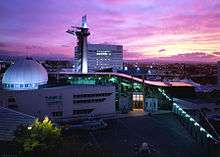
|
|
Climate
Granada has a hot-summer Mediterranean climate (Csa) close to a cold semi-arid climate (BSk) Summers are hot and dry with daily temperatures averaging 34 °C (93 °F) in the hottest month (July); however, temperatures reaching over 40 °C (104 °F) are not uncommon in the summer months. Winters are cool and damp, with most of the rainfall concentrated from November through to January. The coldest month is January with daytime temperatures hovering at 13 °C (55 °F) and dropping to around 1 °C (34 °F) during the night. Frost is quite common as temperatures usually reach below-freezing in the early morning. Spring and autumn are unpredictable, with temperatures ranging from mild to warm. Early summer in 2017 confronted the city with two massive heat waves that broke long-standing record temperatures starting on June 13, 2017, with a new maximum high for the month at 40.6 °C (old record 40.0), which was topped three times within the span of four days at 40.9 °C on June 14, 41.3 (June 15) and, eventually, 41.5 (June 17). The first two days of this heat wave ranked Granada first in both Spain and Europe, making it the hottest place on the given days. The second extreme surge in temperatures followed roughly a month later when readings soared to 45.7 and 45.3 °C on July 12 and 13, respectively, surpassing the old July record by almost 3 degrees.
| Climate data for Granada (Granada Base Aérea, altitude 687 m, 2,254 ft) | |||||||||||||
|---|---|---|---|---|---|---|---|---|---|---|---|---|---|
| Month | Jan | Feb | Mar | Apr | May | Jun | Jul | Aug | Sep | Oct | Nov | Dec | Year |
| Record high °C (°F) | 23.4 (74.1) |
27.6 (81.7) |
29.1 (84.4) |
31.9 (89.4) |
38.6 (101.5) |
40.2 (104.4) |
43.5 (110.3) |
42.0 (107.6) |
40.6 (105.1) |
35.2 (95.4) |
27.6 (81.7) |
24.8 (76.6) |
43.5 (110.3) |
| Average high °C (°F) | 12.6 (54.7) |
14.6 (58.3) |
18.0 (64.4) |
19.5 (67.1) |
24.0 (75.2) |
30.2 (86.4) |
34.2 (93.6) |
33.5 (92.3) |
28.7 (83.7) |
22.6 (72.7) |
16.5 (61.7) |
13.1 (55.6) |
22.3 (72.1) |
| Daily mean °C (°F) | 6.9 (44.4) |
8.5 (47.3) |
11.4 (52.5) |
13.1 (55.6) |
17.1 (62.8) |
22.5 (72.5) |
26.0 (78.8) |
25.5 (77.9) |
21.6 (70.9) |
16.3 (61.3) |
10.9 (51.6) |
7.9 (46.2) |
15.7 (60.3) |
| Average low °C (°F) | 1.2 (34.2) |
2.4 (36.3) |
4.8 (40.6) |
6.8 (44.2) |
10.2 (50.4) |
14.7 (58.5) |
17.7 (63.9) |
17.6 (63.7) |
14.4 (57.9) |
10.1 (50.2) |
5.3 (41.5) |
2.7 (36.9) |
9.0 (48.2) |
| Record low °C (°F) | −12.6 (9.3) |
−13.4 (7.9) |
−6.4 (20.5) |
−1.9 (28.6) |
0.6 (33.1) |
5.6 (42.1) |
9.0 (48.2) |
8.2 (46.8) |
1.2 (34.2) |
−0.5 (31.1) |
−4.5 (23.9) |
−8.6 (16.5) |
−13.4 (7.9) |
| Average precipitation mm (inches) | 41 (1.6) |
33 (1.3) |
35 (1.4) |
37 (1.5) |
30 (1.2) |
11 (0.4) |
2 (0.1) |
3 (0.1) |
23 (0.9) |
38 (1.5) |
50 (2.0) |
50 (2.0) |
353 (14) |
| Average precipitation days | 5.8 | 5.6 | 5.1 | 6.3 | 4.7 | 1.7 | 0.3 | 0.6 | 2.7 | 5.1 | 6.7 | 7.2 | 51.8 |
| Average snowy days | 0.7 | 0.5 | 0.2 | 0.1 | 0 | 0 | 0 | 0 | 0 | 0 | 0.1 | 0.3 | 2 |
| Average relative humidity (%) | 72 | 68 | 60 | 57 | 51 | 43 | 37 | 41 | 51 | 62 | 71 | 75 | 57 |
| Mean monthly sunshine hours | 170 | 172 | 219 | 234 | 280 | 331 | 362 | 330 | 254 | 211 | 164 | 148 | 2,881 |
| Source: Agencia Estatal de Meteorología[32][33] | |||||||||||||
| Climate data for Granada (Granada Airport, altitude 567 m, 1,860 ft) | |||||||||||||
|---|---|---|---|---|---|---|---|---|---|---|---|---|---|
| Month | Jan | Feb | Mar | Apr | May | Jun | Jul | Aug | Sep | Oct | Nov | Dec | Year |
| Record high °C (°F) | 24.6 (76.3) |
26.2 (79.2) |
31.2 (88.2) |
32.7 (90.9) |
39.5 (103.1) |
42.6 (108.7) |
45.7 (114.3) |
43.0 (109.4) |
43.1 (109.6) |
33.5 (92.3) |
27.4 (81.3) |
24.5 (76.1) |
45.7 (114.3) |
| Average high °C (°F) | 13.0 (55.4) |
15.4 (59.7) |
19.0 (66.2) |
20.6 (69.1) |
25.0 (77.0) |
31.0 (87.8) |
34.8 (94.6) |
34.2 (93.6) |
29.4 (84.9) |
23.2 (73.8) |
17.0 (62.6) |
13.4 (56.1) |
23.0 (73.4) |
| Daily mean °C (°F) | 6.6 (43.9) |
8.5 (47.3) |
11.4 (52.5) |
13.3 (55.9) |
17.2 (63.0) |
22.3 (72.1) |
25.3 (77.5) |
24.8 (76.6) |
21.1 (70.0) |
16.0 (60.8) |
10.6 (51.1) |
7.6 (45.7) |
15.4 (59.7) |
| Average low °C (°F) | 0.3 (32.5) |
1.6 (34.9) |
3.8 (38.8) |
6.0 (42.8) |
9.4 (48.9) |
13.6 (56.5) |
15.7 (60.3) |
15.5 (59.9) |
12.8 (55.0) |
8.7 (47.7) |
4.2 (39.6) |
1.7 (35.1) |
7.8 (46.0) |
| Record low °C (°F) | −14.2 (6.4) |
−10.0 (14.0) |
−7.6 (18.3) |
−3.2 (26.2) |
−0.2 (31.6) |
5.0 (41.0) |
6.4 (43.5) |
6.6 (43.9) |
3.6 (38.5) |
−2.6 (27.3) |
−6.4 (20.5) |
−9.2 (15.4) |
−14.2 (6.4) |
| Average precipitation mm (inches) | 42 (1.7) |
38 (1.5) |
32 (1.3) |
36 (1.4) |
28 (1.1) |
11 (0.4) |
2 (0.1) |
4 (0.2) |
19 (0.7) |
40 (1.6) |
54 (2.1) |
56 (2.2) |
365 (14.4) |
| Average precipitation days | 5.6 | 5.9 | 4.9 | 6.2 | 4.2 | 1.7 | 0.3 | 0.6 | 2.8 | 5.0 | 6.8 | 7.4 | 52.1 |
| Mean monthly sunshine hours | 165 | 172 | 225 | 231 | 293 | 336 | 373 | 344 | 262 | 215 | 170 | 149 | 2,935 |
| Source: Agencia Estatal de Meteorología[34][35] | |||||||||||||
_2017-01-04_Sierra_Nevada_y_Granada_desde_Sierra_Elvira_(33432961810)_(cropped).jpg)
Notable people
- Judah ben Saul ibn Tibbon (1120–1190), translator and physician
- Al-Zuhri (fl. 1130s–1150s), geographer
- Ibn Sa'id al-Maghribi (1213–1286), geographer, historian and poet
- Álvaro de Bazán (1526–1588), admiral
- Alonso Cano (1601–1667), painter, sculptor and architect
- Pedro de Mena (1628–1688), baroque sculptor
- José de Mora (1642–1724), baroque sculptor
- Francisco Martínez de la Rosa (1787–1862), statesman, politician, dramatist and poet
- Ángel Ganivet (1865–1898), writer and dramatist
- Mariana Pineda (1804–1831), liberalist heroine
- Eugenia de Montijo (1826–1920), last Empress consort of France
- Mariano Fortuny y Madrazo (1871–1949), painter, photographer, designer and scenographer
- Pablo de Loyzaga (1872–1951), sculptor and professor of fine arts
- Emilio Herrera Linares (1879–1967), military engineer and physicist
- Melchor Fernández Almagro (1893–1966), literary critic, historian and journalist
- Federico García Lorca (1898–1936), poet and dramatist[36][37]
- Francisco Ayala (1906–2009), writer and critic
- Luis Rosales Camacho (1910–1992), poet and essayist from the Generation of '36
- José Tamayo (1920–2003), theatre director
- Manuel Jiménez de Parga (b. 1929), lawyer, politician, diplomat and jurist
- Miguel Ríos (born 1944) rock singer and composer[38]
- Carlos Cano (1946–2000), singer-songwriter
- Manuel Orantes (born 1949), tennis player
- Javier Egea (1952–1999), considered one of the most important Spanish poets of the 1980s
- Luis García Montero (born 1958), poet and literary critic[39][40]
- Chus Gutiérrez (born 1962), film director, actress and journalist
- María José Rienda Contreras (born 1975), ski racer
- Pablo Aguilar Bermúdez (born 1989), basketball player
- Lidia Redondo (born 1992), gymnast
- Sam Hidalgo-Clyne (born 1993), Scotland international rugby union player (born in Granada, but moved to Scotland at age 3)
It is the subject of the 1967 song "Vuelvo a Granada" by Miguel Ríos.[41]
Transport
Construction of a light rail network, the Granada metro, began in 2007. It was greatly delayed by the Spanish economic crisis; service finally started on 21 September 2017.[42] It crosses Granada and covers the towns of Albolote, Maracena and Armilla. Other transportation options in the city of Granada are trains, taxis or buses.
Bus
The main company operating bus transport in Granada is Transportes Rober. There is also bus transportation to and from the airport with the company Alsa.
Rail
Granada railway station has rail connections with many cities in Spain. There are several types of train service to and from Granada[43]
- Short distance trains
- Medium distance trains
- Long distance trains
- AVE (high speed long distance) via the Antequera–Granada high-speed rail line. The closest AVE connection is in Antequera.
Taxi
Granada has a wide network of taxis to help travellers reach their destinations. Official Granada taxis are white with a green stripe.
Airport
The nearest civil airport is Federico García Lorca Airport, about 15 km (9 mi) west of Granada. The Armilla Air Base was the first civil airport serving the city and its surroundings but it was replaced by the former airport in the 1970s and repurposed for military uses.
Granada Public Transportation statistics
The average amount of time people spend commuting with public transit in Granada, for example to and from work, on a weekday is 42 min. 9% of public transit riders, ride for more than 2 hours every day. The average amount of time people wait at a stop or station for public transit is 10 min, while 8% of riders wait for over 20 minutes on average every day. The average distance people usually ride in a single trip with public transit is 2.7 km, while 0% travel for over 12 km in a single direction.[44]
Sports
Granada has an football team:
- Granada CF, in the La Liga
Granada has a basketball team:
- Fundación CB Granada, in LEB Oro
Skiing:
Bullfighting:
- Granada has a 14,507-capacity bullring named Plaza de toros de Granada.
Twin towns and sister cities
Granada shares twin cities status with these cities:[45]
- Aix-en-Provence, France, 1979[45]
- Tetuán, Morocco, 1988[45]
- Tlemcen, Algeria, 1989[45]
- Coral Gables, Florida, United States, 1989[45][46]
- Freiburg im Breisgau, Germany, 1991[45]
- Marrakech, Morocco, 1994[45]
- Belo Horizonte, Brazil, 2002[45]
- Sharjah, United Arab Emirates, 2009[47]
See also
Notes
References
- Municipal Register of Spain 2018. National Statistics Institute.
- Stephanus of Byzantium. Ethnica.
- Ptolemy. The Geography. ii. 4. § 11.
- Pliny. Naturalis Historia. iii. 1. s. 3.
- "10 cosas que solo entenderás si eres de Granada". El blog de los baños árabes • Hammam Al Ándalus (in Spanish). 2018-04-04. Retrieved 2019-12-23.
- RingSalkinLa Boda 1995, p. 296.
- Room 2006, p. 149.
- Dale 1882.
- El Hareir 2011, p. 454.
- Eisenberg, Daniel (2003). "No hubo una Edad 'Media' española". In von der Walde Moheno, Lillian (ed.). Propuestas teorico-metodológicas para el estudio de la literatura hispanica medieval. Universidad Nacional Autónoma de México-Universidad Autónoma Metropolitana. pp. 511–520. ISBN 9789703207770.
- Eisenberg, Daniel (1990). "Judaism, Sephardic". In Dynes, Wayne R. (ed.). Encyclopedia of Homosexuality. Garland. pp. 644–648. ISBN 0824065441.
- "Alhambra, Generalife and Albayzín, Granada". unesco.org. UNESCO World Heritage Centre. Archived from the original on 27 May 2008.
- Colum Hourihane 2012.
- Kennedy, Hugh (1996). Muslim Spain and Portugal: A Political History of al-Andalus. London: Longman. ISBN 0582495156.
- Hugh Kennedy; Professor of Arabic Hugh Kennedy (11 June 2014). Muslim Spain and Portugal: A Political History of Al-Andalus. Routledge. p. 277. ISBN 978-1-317-87041-8.
- "On to al-Andalus and Morocco: 1349 – 1350 | ORIAS". orias.berkeley.edu. Retrieved 2018-04-27.
- "Minaret of San Juan De Los Reyes and Mosque of The Conversos". legadonazari.blogspot.com. Retrieved 18 October 2018.
- "Historical introduction of the Alhambra". Alhambradegranada.org. Retrieved 2011-03-11.
- Granada Jewish History, Piccavey
- "The Generalife". Alhambradegranada.org. Retrieved 2011-03-11.
- Jerez Mir, Carlos: Architecture guide of Granada, Ministry of Culture of Andalusia, pág. 59, ISBN 84-921824-0-7
- "Guide of Monuments of Granada: Cathedral". Moebius.es. Retrieved 2011-03-11.
- "Royal Chapel of Granada. Five hundred years of history". Capillarealgranada.com. Archived from the original on 2011-07-08. Retrieved 2011-03-11.
- "The Al-Andalus legacy – The Albaicín (History)". Legadoandalusi.es. Retrieved 2011-03-11.
- "Educational tours -culturals for the Albayzín". Granada-in.com. Archived from the original on 2016-03-03. Retrieved 2011-03-11.
- "History of the Sacromonte". Guiasdegranada.com. Archived from the original on 2011-07-11. Retrieved 2011-03-11.
- Hierro Calleja, Rafael – Granada y La Alhambra (The Sacromonte. Page 113) ISBN 84-7169-084-5
- Hierro Calleja, Rafael – Granada y la Alhambra (Charterhouse. Page 178) – Ediciones Miguel Sánchez ISBN 84-7169-084-5
- "History of the Charterhouse of Granada". Legadoandalusi.es. Retrieved 2011-03-11.
- Bush, Olga (2015). "Entangled Gazes: The Polysemy of the New Great Mosque of Granada". Muqarnas. 32: 97–134. doi:10.1163/22118993-00321P07.
- "Parques y Jardines de Granada". Granadatur.com. Archived from the original on 2011-04-02. Retrieved 2011-03-11.
- "Valores climatológicos normales. Granada Base Aérea".
- "Valores extremos. Granada Base Aérea". Retrieved 8 August 2017.
- "Valores climatológicos normales. Granada Aeropuerto".
- "Valores extremos. Granada Aeropuerto". Retrieved 8 August 2017.
- "Biografía de Federico García Lorca". Cervantes Virtual (in Spanish). Instituto Cervantes. Retrieved 13 October 2019.
- "Federico García Lorca. Biografía". Instituto Cervantes (in Spanish). Retrieved 13 October 2019.
- Caballero Pérez, Miguel; Góngora Ayala, Pilar (2007). Historia de una familia: la verdad sobre el asesinato de García Lorca. GRUPO IBERSAF. p. 80. ISBN 9788495803597.
- "Luis García Montero. Biografía". Instituto Cervantes (in Spanish). 11 April 2019. Retrieved 13 October 2019.
- "Luis García Montero – Los cien granadinos del siglo XX". Ideal (in Spanish). Retrieved 13 October 2019.
- "Miguel Ríos – El Río / Vuelvo A Granada". Discogs. Retrieved 2016-05-03.
- Barrow, Keith (21 September 2017). "Granada opens first light rail line". railjournal.com. International Railway Journal. Retrieved 21 September 2017.
- "Granada Train". Visit Granada.
- "Granada Public Transportation Statistics". Global Public Transit Index by Moovit. Retrieved June 19, 2017.

- "CIUDADES CON LAS QUE ESTÁ HERMANADA GRANADA" (official website) (in Spanish). Granada, Spain: Ayuntamiento de Granada. Archived from the original on 2014-11-15. Retrieved 2014-12-01.
- "City of Coral Gables : Sister Cities". City of Coral Gables. 2014. Archived from the original on 2015-06-13. Retrieved 2014-03-20.
- "Sultan attends signing of Sharjah-Granada sister city agreement UAE – The Official Web Site – News". Uaeinteract.com. Archived from the original on 2012-09-29. Retrieved 2010-10-03.
Sources
- Ring, Trudy; Salkin, Robert M; La Boda, Sharon (1995). International Dictionary of Historic Places: Southern Europe. Fitzroy Dearborn. ISBN 1-884964-04-4. Retrieved 24 October 2014.CS1 maint: ref=harv (link)
- Room, Adrian (2006). Placenames of the World: Origins And Meanings of the Names for 6,600 Countries, Cities, Territories, Natural Features And Historic Sites. McFarland. p. 149. ISBN 978-0-7864-2248-7. Retrieved 27 December 2012.CS1 maint: ref=harv (link)
- Dale, Alfred (1882). The Synod of Elvira. MacMillan and Co. Retrieved 25 October 2014.CS1 maint: ref=harv (link)
- El Hareir, Idris (2011). The spread of Islam throughout the world. UNESCO. ISBN 978-92-3-104153-2. Retrieved 25 October 2014.CS1 maint: ref=harv (link)
- Colum Hourihane (2012). "Granada". Grove Encyclopedia of Medieval Art and Architecture. Oxford University Press. ISBN 978-0-19-539536-5. Retrieved 5 November 2014.CS1 maint: ref=harv (link)
- Cortés Peña, Antonio Luis and Bernard Vincent. Historia de Granada. 4 vols. Granada: Editorial Don Quijote, 1983.
- Historia del reino de Granada. 3 vols. Granada: Universidad de Granada, Legado Andalusí, 2000.

.jpg)
